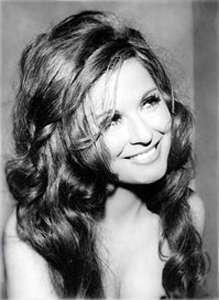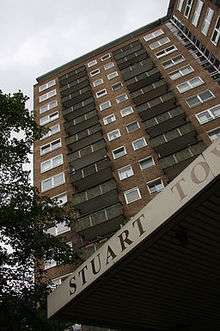Soad Hosny
Soad Hosny (Arabic: سعاد حسني, pronounced [soˈʕæːd ˈħosni]; January 26, 1943[1] – June 21, 2001) was an Egyptian[2] actress born in Cairo. She was known as the "Cinderella of Egyptian cinema" and one of the most influential actresses in the Middle East and the Arab world.[3] She ascended to stardom at the end of the 1950s, performing in more than 83 films between 1959 and 1991. A majority of her films were shot in the 1960s and 1970s. Her final screen appearance was in the 1991 film, The Shepherd and the Women, directed by her ex-husband, Ali Badrakhan.[4]
Soad | |
|---|---|
سعاد حسني | |
 Soad Hosny, c. 1969 | |
| Born | Soad Muhammad Kamal Hosny Kamal El Baba January 26, 1943 |
| Died | June 21, 2001 (aged 58) London, England |
| Nationality | Egyptian |
| Occupation | Actress, singer |
| Years active | 1959–1991 |
Early life and career
Soad Muhammad Kamal Hosny was born in Bulaq district in Cairo, Egypt. She was one of three sisters born to prominent calligrapher Mohammad Hosni, her father from Egyptian village called miet ghamer and her mother an Egyptian woman from Bulaq district, Gawhara.[5][6][7][8] She also had eight half-siblings from her father's first marriage. Her parents divorced and her mother remarried, to an Egyptian man, Abdul Monem Hafeez, with whom she had six more children, thus giving Soad and her two sisters no fewer than 14 half-siblings.[5]
Her father's household was known as "the artists' home" because leading artists from across the Arab world regularly visited Hosni's home in Cairo for tuition and social interaction with the master calligrapher. Her father, whose artistic output included the production of frames for the silent movies and book covers, was well known across the artistic community. A number of his children became performance artists. Soad's half-sister, Najat, was an actress and singer.[6] Her half-brother, Ezz Eddin Hosni (1927–2013), was a music composer and taught both Soad and Najat music and singing. Another sibling, Sami Hosni became a cello player, jewellery designer and also calligrapher.[9] while yet another brother, Farooq, was a painter and his daughter Samira was also an actress.[10]
At the age of three, she began her career when she sang in the popular children's TV program, Papa Sharo. Her work included a wide range of genres – from light comedies and romances through to political satire.[11] Her film debut was in Hasan and Naeima (1959).[12] Her most well-known role was that of a college student who fell in love with her professor in the film, Khali Balak min Zouzou Watch Out for ZouZou (1974).[13] Other important film credits include the role of a student and political activist, who was tortured in Al-Karnak; based on the novel by Naguib Mahfouz. In the film, Shafika she transformed the musical numbers into scathing satires which gave voice to the oppressed. For this and her other hard-hitting, politically relevant roles, she was seen as part of the intelligentsia.[11]
During her lifetime, she was known as the "Cinderella of the screen". She starred in films of every important Egyptian director during the 60s and 70s and played women in complex plots. In her later career, she played women who had been abused or victimised.[14]
Due to illness, she retired from acting in the 1991.[15] Hosny's final screen appearance was in Al Ra'i We El Nissa.[4]
Personal life
Soad Hosny was married four times.[16] Around 1968, she was married to cinematographer Salah Kurayyem; the marriage lasted for approximately one year. In 1970, Hosny was married to the Egyptian film director Ali Badrakhan ; this marriage lasted for approximately eleven years. She was then married to Zaki Fateen Abdel-Wahab, son of Fateen Abdel Wahab and Leila Mourad in 1981. This marriage lasted only five months.
She was romantically linked with various celebrities including the Egyptian film star, Abdel Halim Hafez.[17]
Death

On June 21, 2001, Soad Hosny died after falling from the balcony of her friend Nadia Yousri's apartment in Stuart Tower building in London. Her death was surrounded in controversy, with authorities initially failing to provide details of how she fell; an omission that fuelled media speculation and rumours that her death may have been a suicide or murder, rather than accidental.[18] Soad's body was flown home to Cairo[16] and her funeral in Cairo was attended by some 10,000 people. She was buried in a family's plot of land on the outskirts of Cairo.[19] She had no children and was survived by her last husband, writer Maher Awad, whom she married in 1987.[20][21]
Legacy
In 2013, Lebanese filmmaker Rania Stephan used snippets from Hosny's films to re-tell Hosny's story and the history of Egyptian cinema in The Three Disappearances of Soad Hosny.[22] It was featured in Berlin's Art Week.[23] The Three Disappearances is an important archive, which while following the chronology of Hosni's career, simultaneously documents the costumes, sets and styles used from the 1950s to the 1990s, a period that marked the peak and decline of Egyptian cinema.[24]
One of Hosny's songs, I'm going down to the Square became a popular "anthem" during the Arab Spring of 2011.[24]
Filmography
She appeared in more than 80 films.[12]
References
- "وثيقة مكتوبة : شهادة ميلاد سعاد حسني 1943 م". souad.banouta.net. Retrieved October 31, 2016.
- "Roa'ya Assar – بالمستندات الرسمية: سعاد حسني مصرية و وُلدت... | Facebook". www.facebook.com. Retrieved October 29, 2016.
- "Egyptian Cinderella". Retrieved October 31, 2015.
- "Egyptian screen star dies". BBC News. June 22, 2001. Retrieved February 24, 2012.
- Mayad Beloun. Profile, Alsharq Al Awsat (newspaper), (August 3, 2001), No. 8284.
- Najat Al Saghira profile, najatalsaghira.wordpress.com. Retrieved July 4, 2015.
- Ahmad Al Samehi. Profile, Al-Ahram, December 6, 2012, Issue No. 46021: "Brother of Najat Al Saghira and Soad Hosny: I taught singing to Najat". Retrieved July 4, 2015. (in Arabic)
- "Mohammad Hosni the calligrapher", citytalks.co.uk, June 24, 2015. Retrieved July 10, 2015.
- , Al-Etihad [newspaper], UAE, "Obituary of Ezz- Eldin Hosni"
- Mohammad Qenawi, "Najat Al Saghira wins 'Al Owais' Prize", December 4, 2006, Issue No. 10233. Retrieved January 26, 2016.
- Ginsberg, T. and Lippard, C., Historical Dictionary of Middle Eastern Cinema, Scarecrow Press, 2010, p. 181
- Lentz III, H.M., Obituaries in the Performing Arts, 2001: Film, television, Radio, Theatre, Dance, Music, Cartoons and Pop Culture McFarland, 2002, p. 146
- Ginsberg, T. and Lippard, C., Historical Dictionary of Middle Eastern Cinema, Scarecrow Press, 2010, pp 181–182; It may be worth noting that this source repeats stories occasionally published in the Arabic media, that her father was cruel and denied her an education until age 16 years. Her brother, in a media interview, dismissed this and other rumours about his family life, promulgated by the Arabic media, stressing that he and his siblings were raised in a supportive and artistic household where their talents were nurtured. See: Al-Samahi, A., "Najat's small brother and Suad Hosni: I learned to survive singing", (Interview with composer, Ezzidin Hosny), Al-Ahram, (Arabic newspaper in Egypt), December 6, 2012, Issue No. 46021, , Online: (translated from Arabic)
- Marks, L..U., Hanan Al-Cinema: Affections for the Moving Image, MIT Press, 2015, p. 185
- "Egyptians Mourn Screen Cinderella", BBC News, Online:
- "Egyptians mourn screen Cinderella". BBC News. June 28, 2001. Retrieved February 24, 2012.
- Allam, M., Vincere la Paura, Edizioni Mondadori, 2010, n.p
- Ginsberg, T and Lippard, C., Historical Dictionary of Middle Eastern Cinema Scarecrow Press, 2010, p. 182
- Soad Hosni funeral coverage, albayan.ae, June 29, 2001.
- Al Arabiya (Arabic TV channel, Dubai); "Husbands of screen Cinderella ...". Retrieved June 23, 2011. Retrieved July 10, 2015.
- "Egyptians mourn screen Cinderella". June 28, 2001. Retrieved November 20, 2017.
- Harbord, J., Ex-centric Cinema: Giorgio Agamben and Film Archaeology, Bloomsbury Publishing USA, 2016, p. 101
- Rowan El Shimi, "Cinderella story of Egyptian cinema told through film on Soad Hosny", ahram.org.eg, September 25, 2013.
- Russell, C., Archiveology: Walter Benjamin and Archival Film Practices, Duke University Press, 2018 [E-book edition], n.p.
Sources
- Terri Ginsberg, Chris Lippard, 2010: Historical Dictionary of Middle Eastern Cinema, Scarecrow Press.
- Ashraf Gharib, 2001: Soad Hosni: Al-Hulm Al-Dai (Soad Hosni: The Lost Dream). (Cf. "Return of Soad". Al-Ahram Weekly. November 11–17, 2001. Archived from the original on October 18, 2012. Retrieved February 27, 2012.)
- Mohamed Soweid, 2004: Cabaret Suad, Beirut: Dar al-Adab. (Cf. "The cornflake predicament". Al-Ahram Weekly. June 16–22, 2005. Archived from the original on March 14, 2012. Retrieved February 27, 2012.)
External links
| Wikimedia Commons has media related to Suad Husni. |
- Soad Hosny on IMDb
- "...Zouzou"
- Profile (citing 1943 year of birth), ElCinema.com; (in Arabic) accessed January 26, 2015.
Articles and essays
- "رسالة السندريلا إلى الله!" (in Arabic; gives 1943 as year of birth)
- "Souad Hosny dies in London after struggling with disease", aawsat.com (in Arabic; gives 1944 as year of birth)